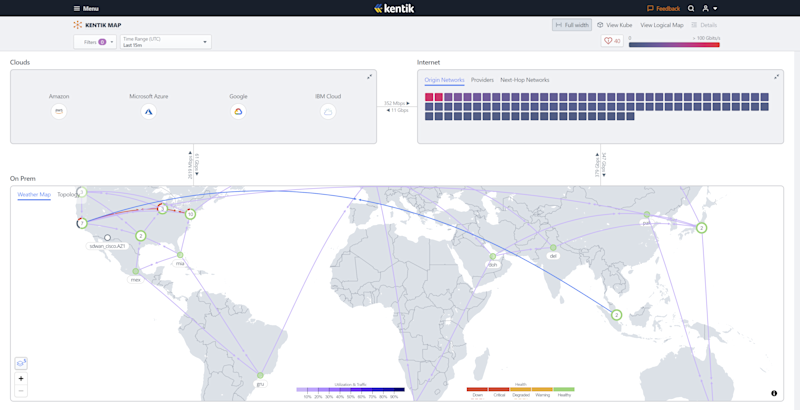What is Network Topology? | Network Topology Mapping & Visualization
Network topology is the way that the nodes on a network are organized in relation to one another. In other words, a network topology is a mapping that shows the routes that devices use to communicate with each other via a network.
With the insights provided by network topology, teams are in a stronger position to trace the flow of data within a network, troubleshoot networking performance problems, identify network segments that are likely to lead to traffic bottlenecks and so on.
This, at least, is the simple definition of network topology. Understanding network topology in the context of modern networks is more complex due to factors like the existence of virtualized network infrastructure and networks that span multiple data centers or clouds.
This article unpacks those nuances while also explaining which techniques and protocols enable the discovery of the network topology.
Mục Lục
Physical vs. virtual network topology
Many modern networks consist not just of physical infrastructure — meaning the hardware switches, routers, cables and other equipment that constitutes the actual network — but also one or more virtual or software-defined networks. The latter networks operate on top of the physical network, placing restrictions on traffic flows and device communication that aren’t enforced at the physical level.
Network topologies must be able to represent the relationship between nodes at both a physical and a virtual level. In other words, a network topology should reveal how virtual machines or containers whose IP addresses are assigned via software, as opposed to physical routers, relate to each other on the network.
Just as important, the topology should also show how virtual network devices map onto physical network infrastructure. For instance, it should identify which physical switches and routers handle traffic for which software-defined network segments or nodes. It’s only by understanding the relationship between physical and virtual software infrastructure that teams can determine the source of networking problems.
Network topology in the cloud
Along similar lines, when networks consist partly or completely of cloud-based infrastructure, network topologies should allow teams to understand how the architecture of the network and the arrangement of nodes within it maps onto cloud infrastructure. They should identify which networks link cloud regions or data centers, as well as the paths that network traffic could take when traveling between different physical locations, both within the same cloud or between clouds.
Discovering network topologies
Modern networks are too large and complex, and they change too quickly to make it practical for engineers to chart their topologies manually. Instead, teams typically deploy network management tools that automatically scan the network and build a topology based on information gathered and organized using specific protocols.
There are multiple approaches to discovering the nodes on a network. A simplistic strategy is simply to send pings to the addresses where nodes may be located, but this approach doesn’t work well because there are usually too many subnets and virtual networks to make it practical. Network management tools may also use the Simple Network Management Protocol, or SNMP, to discover devices. SNMP is more efficient than simply pinging them, but SNMP is not particularly secure, and it may not be running on all devices in a given network.
Today, the most efficient means of discovering a network topology is via the Link Layer Discovery Protocol or LLDP. LLDP allows devices to advertise their location on a network explicitly, making it easy for network topology tools to find them without having to guess at their location. Additional discovery protocols that are similar to LLDP are available from network device vendors, but LLDP has become the standard because it works across all types of devices.

A Geographic View of Network Topology: Kentik Map’s “Weather Map” view provides a visualization of datacenters and network performance by site locations.
Visualizing and mapping network topologies
After network management software identifies the devices on a network and their relationships to each other, it can generate visualizations to represent the topology. Typically, visualizations include labels that identify each node based on data like its hostname or IP address. They also include paths representing the network links that exist between devices.
Below is an example (using the Kentik Network Observability Cloud) topology of a network in AWS.

Network Topology Mapping: Kentik Map builds and presents the topology of the network in real-time, whether on-premises, in the cloud, over the internet or anywhere in between.
By tracing the paths similar to the ones shown above, engineers can quickly visualize which devices are in communication with each other. They can also easily identify points on the network where different segments intersect or where a large volume of traffic depends on a single network link — a situation that could be risky because the link would become a single point of failure that affects many nodes if it were to go down.
SUBSCRIBE
Sign up to receive a monthly roundup of blog posts, tips, and tricks.
Sign up
Real-time network topology
Because modern networks change frequently, it’s not enough to map network topologies on a periodic basis. Network management tools should instead be able to track and visualize network topologies in real-time. Topologies must be updated continuously as nodes join or leave the network, as virtual networks are defined or modified, as address assignments change, and so on.
Real-time insights into complex network topologies are critical for helping to troubleshoot networking problems quickly, before they turn into major disruptions. You don’t want to have to wait to generate an up-to-date network topology before you can begin investigating a network performance issue.
About Kentik Solutions for Network Topology Mapping and Visualization
The Kentik Network Observability Cloud offers a modern, SaaS-based approach to network topology visualization and troubleshooting for today’s hybrid cloud networks.
Start a free trial to try it yourself.















![Toni Kroos là ai? [ sự thật về tiểu sử đầy đủ Toni Kroos ]](https://evbn.org/wp-content/uploads/New-Project-6635-1671934592.jpg)


